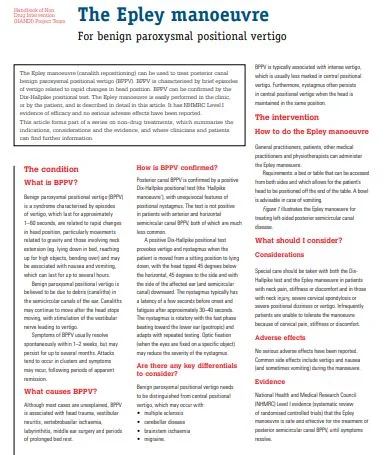‘Epley Maneuver’ PDF Quick download link is given at the bottom of this article. You can see the PDF demo, size of the PDF, page numbers, and direct download Free PDF of ‘BPPV Patient Handout’ using the download button.
Epley Maneuver For Benign Positional Vertigo PDF Free Download

BPPV Patient Handout PDF
The Epley maneuver (canalith repositioning) may be used to treat posterior canal benign paroxysmal positional vertigo (BPPV). BPPV is characterized by brief episodes of vertigo related to rapid changes in head position. BPPV can be confirmed by the Dix-Hallpike positional test.
The Epley maneuver is easily performed in the clinic or by the patient, and is described in detail in this article. It has NHMRC Level I evidence of efficacy and no serious adverse effects have been reported. This article is part of a series on non-drug therapies, summarizing the indications, considerations and evidence, and where clinicians and patients can find more information.
The condition What is BPPV?
Benign paroxysmal positional vertigo (BPPV) is a syndrome characterized by episodes of vertigo, lasting approximately 1–60 seconds, associated with rapid changes in head position, particularly with gravity-related movements and flexion of the neck. Extension-associated movements (eg lying in bed, reaching for tall objects, bending) and may be associated with nausea and vomiting, which may last for several hours.
Benign paroxysmal positional vertigo is believed to be caused by debris (canaliths) in the semicircular canals of the ear. The canalith may continue to move even after head movement has stopped, causing vertigo due to stimulation of the vestibular nerve. Symptoms of BPPV usually get better on their own within 1-2 weeks but can persist for several months. Attacks tend to occur in clusters and symptoms may recur after periods of apparent remission.
What causes BPPV?
Although most cases are unexplained, BPPV is associated with head trauma, vestibular neuritis, vertebrobasilar ischaemia, labyrinthitis, middle ear surgery and periods of prolonged bed rest.
How is BPPV confirmed?
Posterior canal BPPV is confirmed by a positive Dix–Hallpike positional test (‘Hallpike manoeuvre’) with clear features of positional nystagmus. The test is not positive in patients with anterior and horizontal semicircular canal BPPV, both of which are much less common.
A positive Dix-Hallpike positional test elicits vertigo and nystagmus when the patient is moved from a sitting position to a lying position, with the head tilted 45° below horizontal, 45° to the side and to the side of the affected ear (and the semicircular canal) downstream.
Nystagmus typically has a latency of a few seconds before onset and fatigue occurs after approximately 30–40 seconds. Nystagmus moves with a fast phase towards the lower ear (geotropic) and adapts with repeated testing. Optic fixation (when the eyes are fixed on a specific object) can reduce the severity of nystagmus.
Are there any key differentials to consider?
Benign paroxysmal positional vertigo needs to be distinguished from central positional vertigo, which may occur with:
• multiple sclerosis
• cerebellar disease
• brainstem ischaemia
• migraine.
BPPV is typically associated with intense vertigo, which is usually less marked in central positional vertigo. Furthermore, nystagmus often persists in central positional vertigo when the head is maintained in the same position.
How to do the Epley manoeuvre
General practitioners, patients, other medical practitioners and physiotherapists can administer the Epley manoeuvre. Requirements: a bed or table that can be accessed from both sides and which allows for the patient’s head to be positioned off the end of the table. A bowl is advisable in case of vomiting.
What should I consider?
Considerations
Particular care should be taken with both the Dixhallpike test and the Epley maneuver in patients with neck pain, stiffness or discomfort, and in patients with neck injury, severe cervical spondylosis or critical positional vertigo or vertigo. Sometimes patients are unable to tolerate the maneuver due to cervical pain, stiffness or discomfort.
Adverse effects
No serious adverse effects have been reported. Common side effects include vertigo and nausea (and sometimes vomiting) during the manoeuvre.
Evidence
National Health and Medical Research Council (NHMRC) Level I evidence (systematic review of randomised controlled trials) that the Epley manoeuvre is safe and effective for the treatment of posterior semicircular canal BPPV, until symptoms resolve.
Anything else?
In patients refractory to the Epley manoeuvre, diagnoses such as central positional vertigo and anterior and horizontal semicircular canal BPPV should be re-considered. Formal vestibular function testing is sometimes required to confirm the diagnosis.
| Language | English |
| No. of Pages | 2 |
| PDF Size | 0.1 MB |
| Category | Health |
| Source/Credits | racgp.org.au |
Epley Maneuver PDF Free Download
